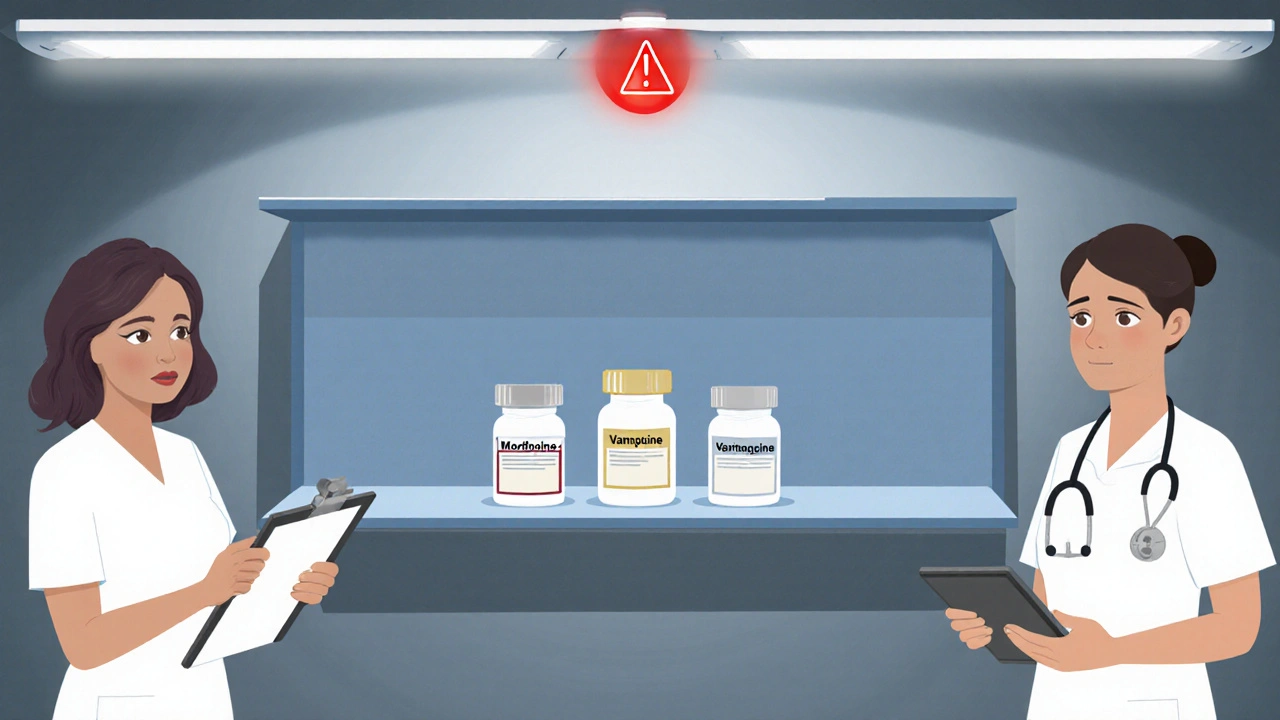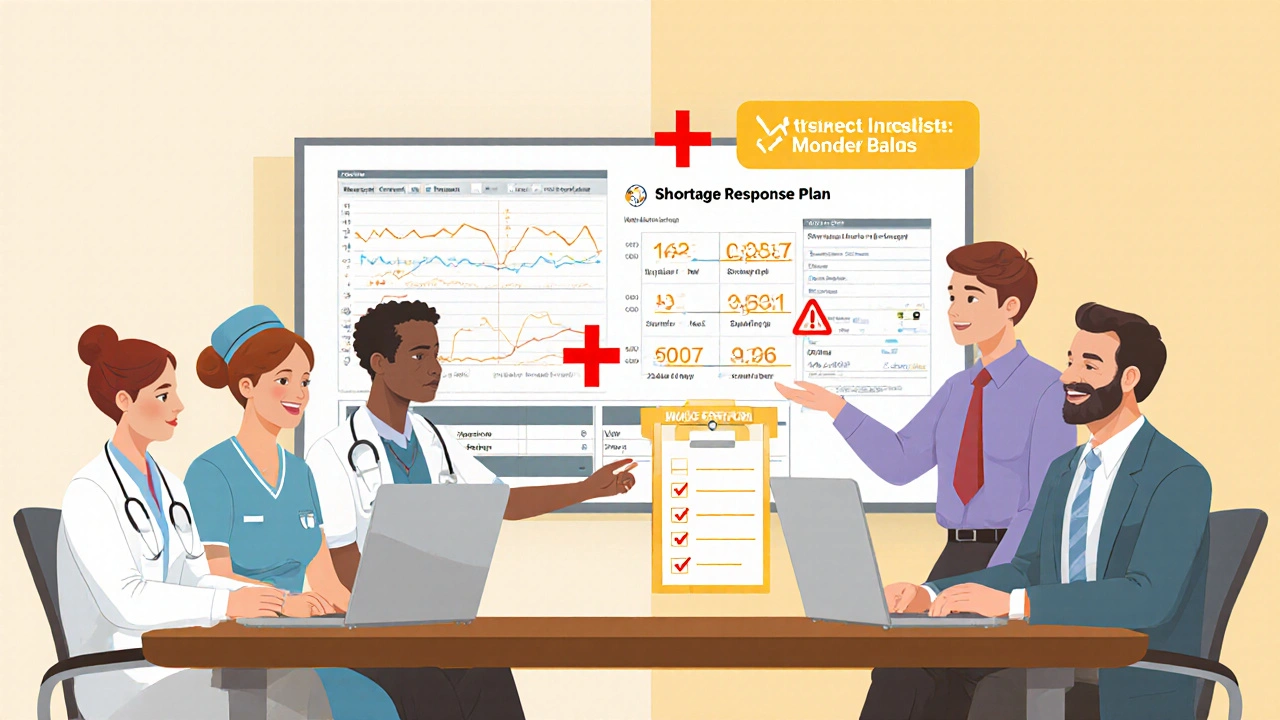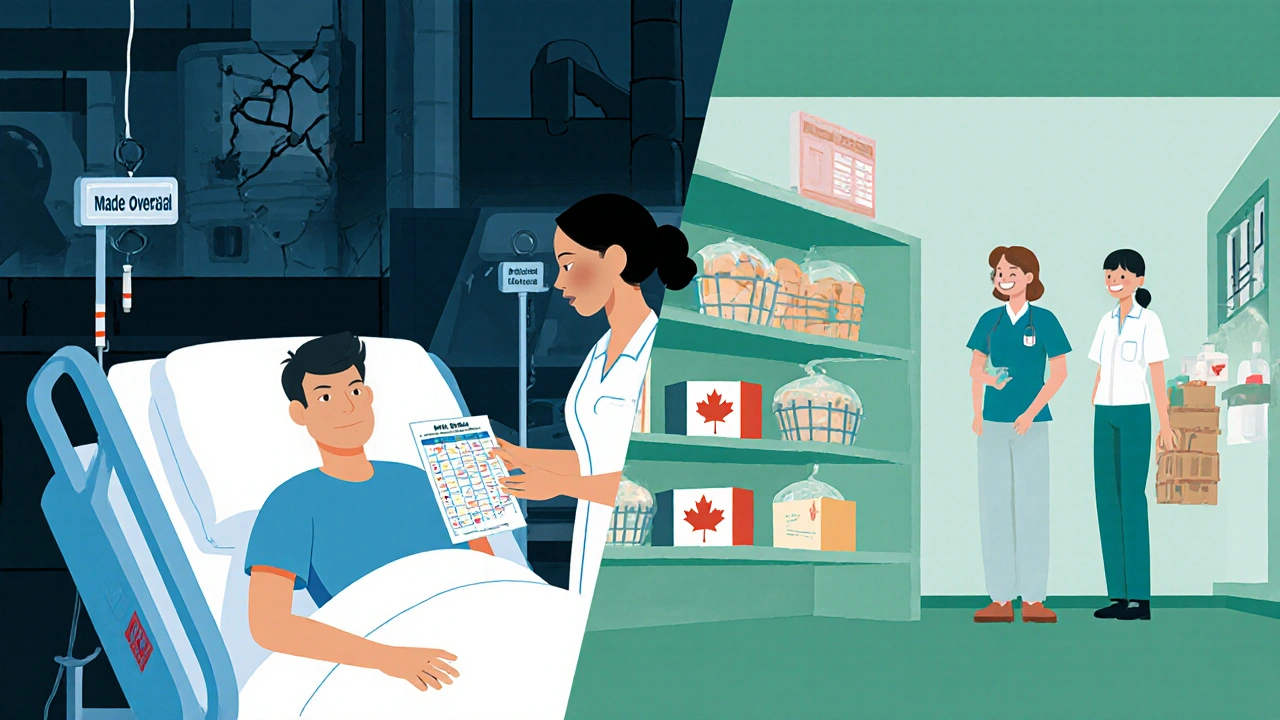Medication Shortages: How to Manage When Drugs Aren't Available
 Nov, 19 2025
Nov, 19 2025
Medication Shortage Substitute Checker
Substitution Request
Results
Recommended Substitute
Equivalent Dose:
Key Considerations
Critical Safety Note
Enter drug details and click "Check Substitution" to see results
When your hospital runs out of morphine, or the IV antibiotics your patient needs don’t arrive, you don’t get a warning. You just wake up to a phone call: medication shortages are here again. And this time, it’s not just one drug-it’s three. And the next one on the list is saline, which every ICU uses hourly. This isn’t rare. It’s routine.
In 2022, the U.S. faced 287 drug shortages, affecting nearly 1 in 5 essential medications in hospitals. The biggest culprits? Generic sterile injectables-things like morphine, vancomycin, propofol, and IV nutrition. These aren’t fancy new drugs. They’re the backbone of emergency care, cancer treatment, and surgery. And they’re disappearing because a handful of manufacturers-just three companies control 75% of the market-are struggling with quality control. Forty-six percent of all shortages in 2022 were caused by manufacturing failures: dirty equipment, mold in production lines, failed inspections. These aren’t supply chain glitches. They’re systemic breakdowns.
Why This Isn’t Just a Pharmacy Problem
When a drug vanishes, it doesn’t just mean a nurse has to scramble. It means a cancer patient gets delayed treatment. A post-op patient waits 22 minutes longer for pain relief. A rural clinic cancels a procedure because they can’t get antibiotics. Eighty percent of U.S. hospitals report that shortages directly affect patient care. Safety-net hospitals-those serving Medicaid and uninsured patients-are hit hardest. Seventy-eight percent say they’ve had to delay or cancel care because of missing drugs.
It’s not just about running out. It’s about what happens next. Substituting hydromorphone for morphine sounds simple, but it’s not. Dosing is different. Side effects vary. In one hospital, medication errors jumped 15% during a morphine shortage. Nurses had to double-check every dose. Pharmacists spent 12.7 extra hours a week managing the chaos. And none of that was planned.
What Hospitals Are Doing Right (And Wrong)
Some hospitals have figured out how to survive. They don’t wait for the phone call. They build systems.
- They form a shortage response team: pharmacists, nurses, IT, risk managers, and finance staff-all trained to act within 4 hours of a shortage alert.
- They track every shortage in a digital log: when it started, what alternatives were tried, how many errors occurred, who was notified, and how long it lasted.
- They run quarterly simulations. When teams practice switching from one drug to another under pressure, medication errors drop by 33% during real shortages.
But most hospitals can’t do this. Why? Because they’re broke. The average hospital spends $218,000 a year managing just one shortage. That’s more than the salary of a full-time pharmacist. Sixty-five percent of safety-net hospitals can’t even keep a 14-day buffer stock of critical drugs. They’re lucky if they have 8 days. And when the drug runs out, they’re forced to improvise.
The Global Picture: Why Other Countries Handle This Better
France and Canada don’t wait for shortages to happen. They prevent them.
They require manufacturers to report potential shortages months in advance. If a company sees a problem coming-bad batch, equipment failure, raw material delay-they must notify the government. That gives hospitals time to find alternatives, adjust budgets, or stockpile. In those countries, shortage durations dropped by 37% after mandatory reporting started.
The U.S. doesn’t. Manufacturers report voluntarily. And only 65% even bother. The FDA’s system relies on goodwill. It doesn’t work. Meanwhile, Germany keeps national stockpiles of critical drugs-morphine, antibiotics, anesthetics. During the 2020-2022 crisis, their shortage impact fell by 52%. The U.S. has a Strategic National Stockpile, but it’s for bioterrorism and pandemics. Not for everyday drug shortages.

Who’s to Blame? The Real Culprits Behind the Scarcity
It’s easy to point fingers at manufacturers. But the problem runs deeper.
Most generic injectables are made overseas-80% of the active ingredients come from China and India. A single quality failure in a factory in Hyderabad can knock out supply for months. And because these drugs are cheap, manufacturers have little incentive to invest in better equipment or backup production lines. Why spend millions upgrading a facility when you’re selling a vial for $1.50?
Medicare and Medicaid reimbursement rules make it worse. The 340B drug pricing program and Medicaid inflation rebates cap what hospitals can pay for generics. If a manufacturer tries to raise prices to cover quality upgrades, they lose money on government contracts. So they don’t upgrade. They cut corners. And when a plant fails, there’s no backup.
Dr. Scott Gottlieb, former FDA commissioner, put it bluntly: “The incentives in this system are backwards.” If you want to fix shortages, you have to pay manufacturers to be reliable-not just cheap.
What You Can Do Right Now
You don’t need a national policy change to start protecting your patients. Here’s what works today:
- Know your critical drugs. Make a list: the top 10 medications your unit can’t do without. Check their availability weekly. Don’t wait for the pharmacy to tell you.
- Build a shortlist of alternatives. For each critical drug, identify one or two clinically appropriate substitutes. Know the dosing differences. Train your team on them. Don’t wing it during a crisis.
- Track your own data. Start a simple log: when a drug runs out, how long it lasted, what you used instead, and if any errors occurred. You don’t need fancy software. A shared Google Sheet works.
- Ask for help early. If you see a drug order is late or reduced, flag it immediately. Don’t wait for the official shortage notice. Most shortages are announced after the fact. By then, it’s too late.
- Push for a shortage committee. Even if your hospital doesn’t have one, start one. Get pharmacists, nurses, and admins together. Meet once a week. Make it part of your routine.

What’s Changing? And Will It Be Enough?
The federal government is trying. In 2022, HHS created a new role: Supply Chain Resilience and Shortage Coordinator. The FDA is finalizing new rules in 2024 that will require manufacturers to give earlier warnings. That could improve detection by 25%.
Some hospitals are testing advanced manufacturing tech-machines that can switch between drug production in hours, not weeks. If adopted widely, this could cut shortages by 40%. But it’s expensive. And it won’t help the 63% of shortages caused by quality failures in aging overseas plants.
The American College of Physicians is pushing for Medicare to reward reliability-not just low cost. If hospitals paid more for drugs from manufacturers with clean inspection records, companies would finally have a reason to invest in quality. That change could bring in $1.5 billion in new funding for infrastructure.
But here’s the truth: none of this will fix the problem overnight. The U.S. is on track for an 8-12% annual increase in shortages through 2030. Oncology, anesthesia, and critical care drugs will be hardest hit.
Bottom Line: Prepare Now, Because Waiting Is Dangerous
Medication shortages aren’t going away. They’re getting worse. And the people who suffer most aren’t CEOs or lawmakers-they’re the patients waiting for pain relief, antibiotics, or cancer treatment.
You can’t control the supply chain. But you can control your response. Build your team. Know your alternatives. Document your decisions. Train your staff. Don’t wait for the system to fix itself. Because if you do, someone’s care will slip through the cracks.
The next time a drug doesn’t arrive, don’t panic. Have a plan. Because in healthcare, when the medicine runs out, the only thing left is your judgment-and your preparation.
robert cardy solano
November 19, 2025 AT 23:58Been there. Saw a patient coded because the norepinephrine ran out and the backup was a different concentration. No one told us until it was too late. We’re just winging it now with spreadsheets and prayers.
And yeah, the pharmacy’s overwhelmed. They’re not the problem. The system is.
Pawan Jamwal
November 21, 2025 AT 00:17USA is a joke. In India, we make 80% of the world’s generics. We don’t have these shortages because we don’t rely on some lazy American manufacturers with dirty labs.
Stop blaming China. Look in the mirror. 🤦♂️
Bill Camp
November 22, 2025 AT 14:24THIS IS WHY AMERICA IS FALLING APART.
One factory in Hyderabad knocks out half the country’s morphine? And we just sit there? No one’s going to jail? No one’s getting fined? We let corporations bleed patients dry for $1.50 vials and call it capitalism?
Someone needs to burn down a few pharma HQs. I’m serious.
Lemmy Coco
November 24, 2025 AT 11:32i’ve been keepin a log of med shortages in my unit since last year. we got a google sheet. it’s not fancy but we’ve caught 3 near-misses already. one time we switched to fentanyl drip early when morphine was delayed and avoided a med error.
still, i wish we had more staff to keep up with it. my nurse manager says we don’t have the budget. sigh.
ps: typo in ‘keepin’ - oops.
rob lafata
November 24, 2025 AT 23:34Let me break this down for you, buttercup. This isn’t a shortage. It’s a corporate murder spree. These companies aren’t failing - they’re *choosing* to fail. Why? Because the FDA lets them. Because Medicare pays pennies. Because no one gives a shit until someone’s kid dies on a ventilator because there’s no propofol.
And guess who’s gonna get blamed? The nurse who gave the wrong dose. The pharmacist who didn’t catch it. The doctor who didn’t know the substitution.
Meanwhile, the CEO’s on a yacht in Monaco, laughing at your tears. You think this is about ‘quality control’? Nah. It’s about profit margins and shareholder dividends. It’s criminal. And it’s legal. Welcome to America.
Matthew McCraney
November 25, 2025 AT 12:30They’re poisoning us. I know this. I’ve seen it. The FDA, the big pharma giants, the Chinese factories - it’s all connected. They’re using these shortages to push us toward ‘alternative treatments’ - think homeopathy, vaccines with microchips, or worse.
Why do you think saline is next? So they can make us buy expensive IV bags from their private labs. It’s all a psyop. The government knows. They just don’t care.
Someone’s tracking our meds. I swear I saw a drone outside the pharmacy last week.
Rusty Thomas
November 26, 2025 AT 15:04OMG I JUST HAD A MELTDOWN BECAUSE WE WERE OUT OF KETAMINE FOR A PATIENT WITH SEVERE AGITATION. I HAD TO USE HALOPERIDOL AND IT WAS A DISASTER. I CRIED IN THE STAFF ROOM. I’M NOT OKAY.
Also, did you see that TikTok where a nurse held a patient’s hand while they waited for morphine? I sobbed. Like, full ugly cry. I’m sharing it with my whole family now. #MedicationShortageTrauma #NursesAreHeroes
Sarah Swiatek
November 27, 2025 AT 15:33It’s not just about the drugs. It’s about what we’ve allowed ourselves to become. We’ve turned healthcare into a commodity, and compassion into a liability. We reward the cheapest bid, not the safest process. We celebrate efficiency over ethics. We’ve outsourced our humanity to a factory in Bangalore that can’t afford to fix a leaky pipe.
And now we’re surprised when the system collapses? We built this. We chose this. We looked away while the vials ran dry.
Maybe the real question isn’t ‘how do we fix this?’
It’s ‘how do we stop pretending we’re healing people when we’re just managing decline?’
Dave Wooldridge
November 28, 2025 AT 10:39They’re using this to push RFID chips in the IV bags. I heard it from a guy who works at the FDA. He said if you look at the barcode patterns during shortages, they’re all syncing with the new ‘smart hospital’ rollout. It’s not a shortage - it’s a rollout. They want us dependent on tech so they can control the meds remotely.
And don’t get me started on the satellite monitoring. I saw a drone over the pharmacy last Tuesday. It was blinking red. I took a photo. I’m sending it to Alex Jones.
Rebecca Cosenza
November 29, 2025 AT 19:03My mom died because they couldn’t get her antibiotics. I’m not okay.
They knew. They knew for weeks. No one told us.
That’s all.